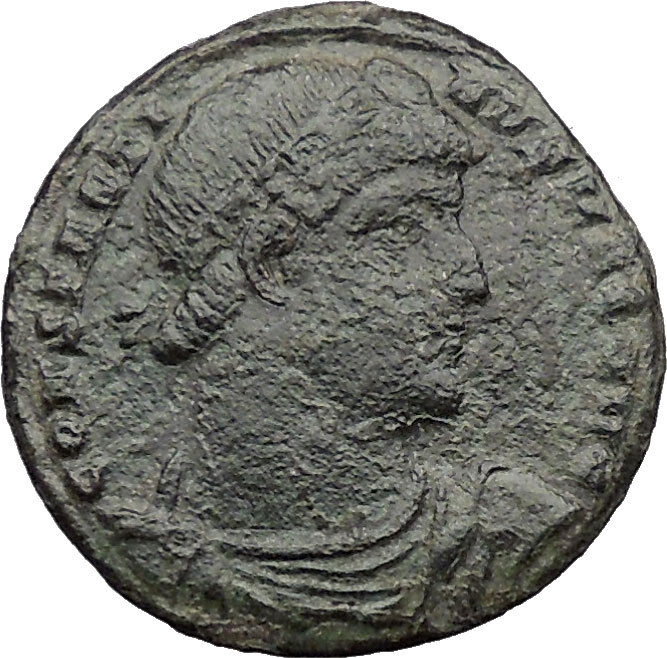|
Volusian – Roman Caesar: 251-253 A.D.
Silver Antoninianus 20mm (3.39 grams) Rome mint, struck circa 252 A.D.
Reference :RIC IV 180; RSC 71
IMP CAE C VIB VOLVSIANO AVG, radiate, draped, and cuirassed bust right.
PAX AVG G, Pax standing left, holding branch and transverse sceptre, star in right field. .
You are bidding on the exact item pictured, provided with a Certificate of Authenticity and Lifetime Guarantee of Authenticity.
.jpg/200px-Statue_of_the_goddess_Pax_(Pavlovsk_Garden,_St_Petersburg,_Russia).jpg) In Roman mythology, Pax (Latin for peace) (her Greek equivalent was Eirene) was recognized as a goddess during the rule of Augustus. On the Campus Martius, she had a temple called the Ara Pacis, and another temple on the Forum Pacis. She was depicted in art with olive branches, a cornucopia and a scepter. There was a festival in her honor on January 3. Daughter of Jupiter and Iustitia. Pax was often associated with spring. This word is of very frequent occurrence on Roman coins, nor is it always possible to decide as to which particular pacification it is to be referred. In Roman mythology, Pax (Latin for peace) (her Greek equivalent was Eirene) was recognized as a goddess during the rule of Augustus. On the Campus Martius, she had a temple called the Ara Pacis, and another temple on the Forum Pacis. She was depicted in art with olive branches, a cornucopia and a scepter. There was a festival in her honor on January 3. Daughter of Jupiter and Iustitia. Pax was often associated with spring. This word is of very frequent occurrence on Roman coins, nor is it always possible to decide as to which particular pacification it is to be referred.
Pax, regarded by the ancients as a goddess, was worshipped not only at Rome but also at Athens. Her alter could not be stained with blood. The Emperor Claudius began the construction of a magnificent temple to her honor, which Vespasian finished, in the Via Sacra. Singular to say, no representation of the superb Temple of Peace, built by Vespasian, appears on coins of that Emperor, nor of his son Titus.–See Templum Pacis. The attributes of Peace, as exhibited on medals, are the haste pura, the olive branch, the cornucopiae; and often the caduceus. Sometimes (as on coins of Vespasian, Domitian, and M. Aurelius) she is represented setting fire to a pile of arms.
Peace was considered to be in the power of him, to whom belonged the auspices (auspicia); whence, according to Dion, the Caesars were called the Lords of Peace and War (Pacis et Belli Domini). Accordingly we find coins of the Emperors proclaiming Pax AVGusta, or AVGusti; Pax Aeterna; Pax Perpetua; Pax Fundata; Pax Publica; Pax Ubique Parta; and these inscriptions are accompanied by various symbols such as the Temple of Peace, as on medals of Augustus, or the Temple of Janus shut, as on those of Nero; or a woman holding a cornucopiae in her left hand as in Augustus, Hadrian, &c. The symbol of Eternal Peace, as manifested in the figure of the goddess setting fire to a heap of armor both offensive and defensive, is seen on coins of Galba, Vitellius, Vespasian, Antoninus Pius, and Aurelius, as in Pax Augusti. The head of pax is seen on denarii of Julius Caesar and of Augustus.
Gaius Vibius Volusianus (d. August, 253) was a Roman emperor (251 – 253).
He was son to Gaius Vibius Trebonianus Gallus by his wife Afinia Gemina Baebiana. He is known to have had a sister, Vibia Galla.
The death of Decius in early June, 251 led to Trebonianus Gallus’ elevation to the throne. Gallus adopted Decius’ son Hostilian and made him co-ruler. Volusianus was named Caesar and Princeps Juventutis. Later in 251 Hostilian died of the plague and Volusianus replaced him as Augustus and co-ruler.
Father and son were both killed in 253 by mutinous troops in Interamna.
|





.jpg/200px-Statue_of_the_goddess_Pax_(Pavlovsk_Garden,_St_Petersburg,_Russia).jpg) In Roman mythology, Pax (Latin for peace) (her Greek equivalent was Eirene) was recognized as a goddess during the rule of Augustus. On the Campus Martius, she had a temple called the Ara Pacis, and another temple on the Forum Pacis. She was depicted in art with olive branches, a cornucopia and a scepter. There was a festival in her honor on January 3. Daughter of Jupiter and Iustitia. Pax was often associated with spring. This word is of very frequent occurrence on Roman coins, nor is it always possible to decide as to which particular pacification it is to be referred.
In Roman mythology, Pax (Latin for peace) (her Greek equivalent was Eirene) was recognized as a goddess during the rule of Augustus. On the Campus Martius, she had a temple called the Ara Pacis, and another temple on the Forum Pacis. She was depicted in art with olive branches, a cornucopia and a scepter. There was a festival in her honor on January 3. Daughter of Jupiter and Iustitia. Pax was often associated with spring. This word is of very frequent occurrence on Roman coins, nor is it always possible to decide as to which particular pacification it is to be referred.




